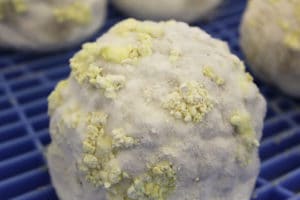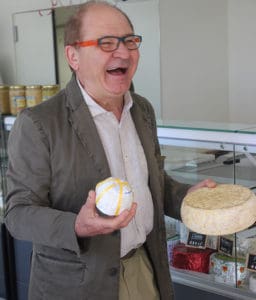
Why do doughnuts have holes? In 1916 a writer for The Boston Post posed the timeless question to the snack’s supposed inventor, Hanson Gregory.
“They used to fry all right around the edges, but when you had the edges done the insides was all raw dough,” responded the New England ship captain, who often whipped up dough balls to feed his hungry crew. In the interest of even cooking, Gregory sliced a void in the middle of his creations. “I says to myself, ‘Why wouldn’t a space inside solve the difficulty?’ . . . and so I cut into that doughnut the first hole ever seen by mortal eyes!”

Affineur Rodolphe Le Meunier wraps a slice of Puits d’Astier at his aging caves near Tours, France
Fast forward a century to a sprawling aging cave near Tours, France, where affineur Rodolphe Le Meunier holds up Puits d’Astier, a cheese that looks like a wide, flattened doughnut. Dusted in frostinglike white fuzz and sprinkled with yellow mold, the wheel has a hole in the middle and bulging edges. I’m well aware how very Américaine it is of me to compare an artisanal fromage to a Yankee junk food—still, I ask Le Meunier what the Puits would be without that hole. Lo and behold, the metaphor has merit.
“Of course, it wouldn’t be the same,” he says. It’s all about the maturation—“normally a cheese ages from the outside to the inside.” Sans inner cavity, explains the affineur, the wheel would age starting from its far outer edges, creeping toward the center. But with that extra surface area, maturation happens more evenly, ripening not only from the outer rind inward but also from the inner circle towards the outer rind.
Sure, there are plenty of cheese wheels that age just fine without a space inside. But the Puits d’Astier is delicate; the moist and creamy uncooked sheep’s milk curd results in a paste that becomes fondantesque over time—almost to the point of collapsing. And for a cheese this soft, it’s uncommonly large: 16 inches in diameter, to be exact. Without that hole, maturation would soften the outer edges too quickly, leaving the inside firm and rubbery. (A bit like Captain Gregory described: “When you had the edges done, the insides was all raw.”) “If one used a small mold to make a small wheel of it, aging would be easy,” he says. But for the hulking, ooze-prone Puits, “it’s different.” He presses gently on the outside edge of the wheel. “You see how it’s supple there? It’s truly, truly creamy.”

Le Meunier knows Puits well because he’s the affineur overseeing its striking transformation. Wheels arrive at his aging cave in the village of La Croix-en-Touraine when they’re about two months old. At that point they’re firmer with sharper edges and a dusting of white mold—and they’re hiding a secret. They’ve already been colonized by molds that will burst to life over the next six weeks, yielding fuzzy patches in light and dark shades of gray. Most striking of all are the yellow, cloudlike colonies of Chrysosporium sulfureum, which emerge slowly in spots where other fungi have been growing for some time.
Among the smooth, tawny Comtés and Ossau-Iratys in Le Meunier’s aging cave, the Puits’ distinctive fuzz stands out, hinting at its true origins. According to Tufts University microbiologist Benjamin Wolfe, yellow C. sulfureum is found in a few different places in the world—in the nests of leaf-cutting ants and on mushroom farms, for instance—but it’s particularly prevalent in natural caves in the Auvergne region of France.
And that’s exactly where the Puits is made: two hundred miles away, in the Auvergne. At Laiterie Antoine Garmy in the Astier village of Orléat, Bertrand Poussous guides me into a small aging room stuffed with cheeses covered in that white-gray-yellow combo. When Garmy first developed the cheese in 1980, it was aged in natural caves near Clermont-Ferrand alongside wheels of AOP Saint-Nectaire. That’s where they first developed the mold, says the head cheesemaker, and “when we moved it here, the mold contaminated this room . . . and we kept it.”

A small Gaperon round used to cultivate and spread molds to new Puits d’Astier wheels
Scattered throughout are small rounds of Gaperon, another Garmy cheese. Normally these dome-shaped cow’s milk rounds are sold with faint white dusty rinds, but here they have thick manes of fuzz interspersed with bulging C. sulfureum colonies. Nobody will eat them; their sole purpose is only to keep the mold spores circulating, colonizing new Puits wheels. By the time the wheels reach Le Meunier’s cave, he’ll just need to carefully control the temperature and humidity and let the rind do its thing. The whole process is an exercise in cultivating an ecosystem with patience. “We must keep the ambience,” Poussous explains.

Managing director Francis Bouyssou shows off some of Garmy’s original cheeses in the dairy’s on-site shop
The sheep’s milk Puits is all the more impressive given that in a region with a historic dependence on cow’s milk and very few sheep, Garmy has undertaken the daunting task of creating such a large-format sheep’s milk cheese. It hasn’t always been easy; the dairy has had to work closely with local farmers over decades to help them adopt and improve their ewe’s milk production. A shaky period during the financial crisis in 2011 left Garmy with a surplus of milk, forcing them to sever some of these ties, which they’re now rebuilding. Bouyssou, a former management executive for a photobooth company, came out of retirement—“I’m a little crazy,” he explains—to help update and streamline the third-generation dairy company.



